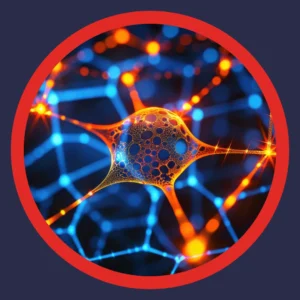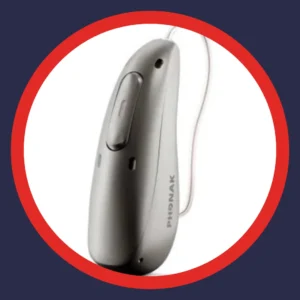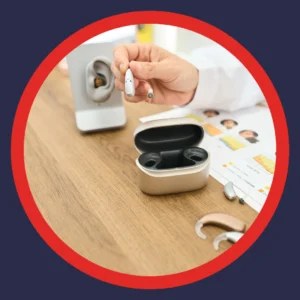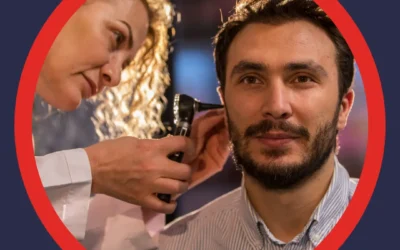The transformation of hearing aid technology over the past decade represents one of healthcare’s most remarkable innovations. What once simply made sounds louder now thinks, learns, adapts, and even monitors your health. Today’s devices use artificial intelligence trained on millions of sound environments to deliver clarity that feels natural and effortless.
This evolution changes what it means to wear hearing aids. Modern devices don’t just help you hear better. They reduce mental fatigue, connect seamlessly to your digital life, and support your overall wellness. Understanding these advances helps you make informed choices about your hearing health.
Research shows that hearing aid technology now uses deep neural networks and motion sensors. These innovations deliver unprecedented speech clarity while tracking health metrics. The latest generation represents a fundamental shift from programmed devices to intelligent companions.
How Modern Hearing Aid Technology Actually Works
Understanding the basics helps you appreciate how far hearing aid technology has advanced. Every hearing aid, regardless of style or generation, contains three core components working together.
The Three Essential Parts
Microphones pick up sound waves from your environment. They convert acoustic energy into electrical signals. Modern hearing aids use multiple directional microphones that can focus on specific sound sources.
Processors serve as the brain of the device. Advanced hearing aid technology converts analog signals into digital code. This allows sophisticated analysis and modification of every sound element. The processor determines which frequencies need amplification and which sounds should be reduced.
Receivers take the processed signal and convert it back to sound waves. These tiny speakers deliver sound directly into your ear canal. The goal is making quiet sounds audible while keeping loud sounds comfortable.
The magic happens in the processing stage. Current hearing aid technology uses artificial intelligence to analyze sound environments hundreds of times per second. This creates listening experiences that adapt instantly to your surroundings.

Deep Neural Networks: Teaching Hearing Aids to Think
Deep neural networks represent the most significant advancement in hearing aid technology. These AI systems learn from millions of real-world sound scenarios. They recognize patterns and make decisions similar to human brain processing.
What Makes Neural Processing Different
Traditional hearing aids used fixed rules for sound processing. If background noise exceeded a certain level, the device would reduce it uniformly. This approach often muffled important sounds along with unwanted noise.
Neural network hearing aid technology takes a smarter approach. The system analyzes the complete sound environment continuously. It identifies speech patterns, recognizes different types of noise, and understands spatial relationships between sounds. This allows for precise separation of voices from background interference.
Studies confirm that DNN-based hearing aids significantly improve speech understanding. Users report higher satisfaction with sound quality compared to conventional processing. The difference is particularly noticeable in challenging listening environments.
Real-World Benefits of Neural Processing
The advantages extend beyond technical specifications. People using neural network hearing aid technology experience:
Reduced listening effort in noisy restaurants and social gatherings. The brain doesn’t have to work as hard to separate speech from background sounds. This reduces mental fatigue significantly.
More natural sound quality that preserves environmental awareness. You hear conversations clearly while remaining aware of your surroundings. This matters for safety and comfort.
Automatic adaptation as you move between environments. The system recognizes when you enter a quiet office or noisy street. Adjustments happen instantly without manual intervention.
Better music appreciation through more accurate sound reproduction. Neural processing preserves the complexity and richness of musical instruments.
Leading Neural Network Systems
|
Brand |
Technology Name |
Key Capability |
Best For |
|
Starkey |
DNN 360 with G3 Processor |
Analyzes speech, noise, and motion simultaneously |
Active users in varied environments |
|
Phonak |
DEEPSONIC AI Chip |
Extracts speech from any direction in real time |
Group conversations in noise |
|
Oticon |
DNN 2.0 with Sirius Chip |
Provides 35% more speech cues |
Natural, complete sound scenes |
|
ReSound |
Intelligence Augmented DNN |
Separates speech 17 times more efficiently |
Everyday listening comfort |
These systems represent the cutting edge of hearing aid technology. Each brand approaches neural processing differently, but all deliver substantial improvements over previous generations.
Motion Sensors and User Intent Recognition
Breakthrough hearing aid technology now includes sensors that detect your movements and intentions. These tiny accelerometers and gyroscopes track head position, body motion, and even subtle gestures. This adds crucial context to sound processing.
Understanding 4D Sensor Technology
Oticon Intent hearing aids pioneered 4D sensor technology. The system monitors four key factors continuously:
Conversation activity indicates when you’re engaged in dialogue. The hearing aids detect speech patterns and adjust focus accordingly.
Head movement reveals listening intention. When you turn toward a speaker, the system recognizes your interest. It instantly shifts processing to enhance that voice.
Body movement affects how sound should be processed. Walking requires different settings than sitting still. The sensors adjust microphone behavior based on your activity level.
Acoustic environment analysis completes the picture. The hearing aids combine motion data with sound analysis. This creates highly personalized processing that matches your immediate needs.
Why Motion Sensing Matters
The benefits of motion-aware hearing aid technology show up in daily life:
Enhanced conversations happen when devices detect your listening focus. You don’t need to adjust settings manually. The hearing aids anticipate what you want to hear.
Improved safety comes from maintained environmental awareness. Motion sensors help preserve spatial audio cues. You can locate sounds around you more accurately.
Reduced cognitive load results from automatic, appropriate adjustments. Your brain doesn’t need to work overtime processing unclear sound. Mental energy stays available for understanding and engagement.
Better balance support emerges from motion tracking data. Some hearing aid technology now monitors gait and stability patterns. This information can identify fall risk early.
Health Tracking: Beyond Better Hearing
Current hearing aid technology extends into comprehensive wellness monitoring. Devices now track vital signs, physical activity, and safety metrics. This transforms hearing aids into health companions you wear all day.
Revolutionary Safety Features
Starkey Omega AI introduced automatic respiratory rate tracking. Built-in motion sensors detect subtle chest movements during rest. The system calculates your resting breaths per minute passively. Tracking changes in respiratory rate offers insight into overall wellness.
Balance Builder exercises guide you through stability training. The program uses motion sensor data from your hearing aids. Regular practice improves coordination and reduces fall risk. This represents proactive prevention rather than reactive detection.
Fall detection technology recognizes dangerous falls automatically. When a fall occurs, the hearing aids send GPS alerts to emergency contacts. Your location appears immediately in the notification. This ensures fast assistance when you need it most.
Activity and Wellness Monitoring
Modern hearing aid technology tracks daily movement patterns:
Step counting motivates physical activity throughout your day. The hearing aids monitor your movement continuously. Data appears in smartphone apps for easy review.
Social engagement tracking measures conversation time and interaction frequency. Active social lives link to better cognitive health. The hearing aids help you stay aware of important health behaviors.
Heart rate monitoring appears in select models. Sensors in the ear canal detect pulse accurately. This provides cardiovascular insight without separate fitness devices.
|
Health Feature |
How It Works |
Available In |
Primary Benefit |
|
Fall Detection |
3D motion sensors detect impact patterns |
Starkey Omega AI, Edge AI |
Emergency GPS alerts to contacts |
|
Balance Builder |
Guided exercises using motion data |
Starkey Omega AI |
Proactive fall prevention |
|
Respiratory Tracking |
Chest movement detection during rest |
Starkey Omega AI |
Vital sign monitoring |
|
Activity Tracking |
Step counting and movement analysis |
Most premium models |
Fitness motivation |
|
Heart Rate Monitoring |
Pulse detection via ear canal |
Select Phonak models |
Cardiovascular awareness |
These features make hearing aid technology valuable even when you’re not actively listening. The devices support your health continuously throughout the day.
Bluetooth LE Audio and Auracast: Connection Reimagined
Wireless connectivity represents another transformative advancement in hearing aid technology. Bluetooth Low Energy Audio and Auracast have eliminated the limitations of earlier systems. Modern devices connect to virtually any audio source with superior quality and efficiency.
What Bluetooth LE Audio Delivers
The latest Bluetooth standard brings substantial improvements:
Lower power consumption extends battery life significantly. Streaming music or taking calls no longer drains batteries quickly. Most hearing aids now last all day even with heavy Bluetooth use.
Higher audio quality comes from the LC3 codec. This compression system delivers clearer sound with less data. Music, podcasts, and phone calls all sound noticeably better.
Universal compatibility works with both iOS and Android devices. You can connect to smartphones, tablets, computers, and smart TVs. The connection process is simple and reliable.
Multi-stream capability allows different audio to each ear. This matters for specific listening situations and future applications. The flexibility opens new possibilities for hearing aid technology.

Auracast: Public Audio Broadcasting
Auracast technology will transform how you experience public spaces. This Bluetooth Audio Broadcasting standard allows direct connection to venue sound systems. Hearing aids with Bluetooth can access Auracast broadcasts easily.
Imagine sitting in a theater where dialogue streams directly to your hearing aids. Airport announcements become crystal clear without straining to hear overhead speakers. Gym classes, museums, and conference centers can broadcast audio that you control personally.
Current Auracast-ready hearing aid technology includes:
- ReSound Vivia with Auracast Assistant in the app
- Starkey Omega AI and Edge AI models
- Phonak Audéo Sphere and Infinio series
- Oticon Intent with LE Audio streaming
Venues are beginning to install Auracast transmitters. Your hearing aids will be ready when this technology becomes widespread.
Streaming Benefits in Daily Life
Wireless hearing aid technology enhances routine activities:
Phone calls stream directly to both ears in stereo. Conversations sound natural and clear. Background noise fades as speech receives priority processing.
Television audio comes through without disturbing others. You set your preferred volume independently. Family members can watch at comfortable levels too.
Music streaming preserves quality and detail. Whether listening to podcasts during walks or enjoying favorite albums, sound remains rich and full.
Video meetings improve dramatically with direct audio. You hear every participant clearly without room acoustics interfering. This matters for work and staying connected with family.
Rechargeable Power: Convenience Meets Performance
Battery technology has evolved to match the demands of advanced features. Rechargeable hearing aid technology eliminates the hassle of tiny disposable batteries. Lithium-ion systems now deliver reliable all-day power with simple overnight charging.
Why Rechargeable Systems Changed Everything
The shift to rechargeable batteries solved multiple problems simultaneously:
Easier handling benefits everyone, particularly those with limited dexterity. You place hearing aids in a charging case each night. No fumbling with small battery doors or tiny cells.
Environmental benefits reduce waste significantly. Disposable hearing aid batteries create tons of hazardous waste annually. Rechargeable systems eliminate this completely.
Consistent power delivery supports demanding features reliably. AI processing, Bluetooth streaming, and health monitoring all require steady energy. Rechargeable batteries provide this better than disposables.
Lower long-term costs add up over time. While initial investment is slightly higher, you never buy batteries again. The savings become substantial over several years.
Current Battery Performance
Modern rechargeable hearing aid technology offers impressive runtime:
|
Model |
Battery Life |
Quick Charge |
Charging Case |
|
Starkey Omega AI |
Up to 51 hours |
30 min = 8 hours |
Portable option |
|
Phonak Audéo Sphere |
Up to 56 hours |
Quick charge available |
Standard and portable |
|
Oticon Intent |
Up to 20 hours |
30 min = 4 hours |
Desktop charger |
|
ReSound Vivia |
Up to 30 hours |
Quick charge supported |
Compact design |
These numbers reflect typical use with moderate Bluetooth streaming. Even heavy users get full-day reliability. Quick charge features provide backup when needed.
The combination of long runtime and convenient charging makes rechargeable hearing aid technology the preferred choice. Most new hearing aid purchases now include rechargeable options.
Specialized Solutions: Tinnitus and Single-Sided Hearing
Advanced hearing aid technology now addresses specific conditions that once had limited options. Whether you experience tinnitus or hear well in only one ear, modern solutions provide effective support.
Tinnitus Relief Through Smart Sound Therapy
Tinnitus affects millions of adults, creating persistent ringing, buzzing, or humming sensations. Current hearing aid technology integrates adaptive relief features:
AI-driven sound therapy generates customized masking tones. The system adjusts relief sounds based on your environment automatically. This provides consistent comfort without interfering with normal listening.
Personalized settings through smartphone apps let you control intensity and tone. You can modify relief sounds based on daily comfort levels. The hearing aids remember your preferences.
Neural processing integration helps your brain refocus away from tinnitus signals. By providing rich, complete sound environments, hearing aid technology reduces tinnitus awareness naturally.
Ocean wave therapy and other nature sounds blend seamlessly with ambient audio. The relief feels natural rather than artificial or distracting.
See the best hearing aids for seniors with tinnitus.
CROS Technology for Single-Sided Hearing
People with hearing loss in one ear face unique challenges. CROS hearing aid systems use wireless hearing aid technology to transmit sound from the weaker side to the better ear.
Modern CROS solutions provide:
Instant wireless transmission with no perceptible delay. Sound from your non-hearing side reaches your good ear immediately.
Preserved spatial awareness so you can locate sound sources. The system maintains directional cues despite routing audio.
Reduced listening effort in conversations and meetings. You don’t need to position yourself strategically constantly.
Discreet, comfortable designs that look like standard hearing aids. Nobody notices you’re using assistive technology.
Leading CROS-compatible hearing aid technology includes Phonak CROS systems and ReSound CROS options. These work seamlessly with corresponding hearing aids on the better ear.
Comparing Premium Hearing Aid Technology
Understanding how top brands approach innovation helps you recognize what matters most. Each manufacturer emphasizes different aspects of hearing aid technology based on their research and philosophy.
Brand Approaches to Innovation
Starkey focuses on comprehensive health integration. Their hearing aid technology includes the most extensive wellness tracking available. Fall detection, Balance Builder exercises, and respiratory monitoring set Starkey apart. The G3 Gen AI Neuro Processor powers DNN 360 directionality for excellent speech clarity.
Phonak prioritizes speech understanding in extreme noise. The proprietary DEEPSONIC chip processes sound using advanced neural networks. Spheric Speech Clarity 2.0 extracts voices from chaotic group conversations. Comparing Phonak and Starkey reveals different strengths for different needs.
Oticon emphasizes brain-friendly sound processing. Their BrainHearing philosophy delivers complete sound scenes rather than isolated speech. 4D sensor technology adapts based on user intention. This approach maintains natural environmental awareness.
ReSound balances power with compact design. ReSound Vivia offers the smallest rechargeable option with full premium features. Intelligence Augmented DNN provides efficient speech separation. Auracast readiness future-proofs your investment.
Technology Comparison Across Brands
|
Feature |
Starkey Omega AI |
Phonak Sphere |
Oticon Intent |
ReSound Vivia |
|
Neural Processing |
DNN 360 (G3) |
DEEPSONIC Chip |
DNN 2.0 (Sirius) |
Intelligence Augmented |
|
Motion Sensors |
Yes, for health tracking |
Limited |
4D sensors |
Movement tracking |
|
Fall Detection |
Automatic with GPS alerts |
No |
No |
No |
|
Health Features |
Respiratory, Balance Builder |
Heart rate option |
HearingFitness tracking |
Tinnitus support |
|
Battery Life |
Up to 51 hours |
Up to 56 hours |
Up to 20 hours |
Up to 30 hours |
|
Bluetooth |
LE Audio, Auracast-ready |
LE Audio, Dual-Mode |
LE Audio hands-free |
LE Audio, Auracast-ready |
|
Size Options |
8 styles |
Multiple RIC/ITE |
Several miniRITE |
Smallest rechargeable |
|
Best For |
Health-conscious users |
Extreme noise situations |
Natural sound seekers |
Discreet, powerful option |
This comparison shows that hearing aid technology has reached remarkable sophistication across all premium brands. Your choice depends on which features matter most for your lifestyle and needs.
What to Expect from Your Hearing Care Provider
Getting the full benefit of modern hearing aid technology requires professional guidance. Your hearing care provider plays an essential role in selection, fitting, and ongoing optimization.
The Comprehensive Evaluation Process
Advanced hearing aid technology starts with thorough assessment. Your hearing care provider will conduct detailed testing to understand your specific hearing loss pattern. This determines which technology features will benefit you most.
Speech-in-noise testing reveals how well you understand conversation in challenging environments. Results guide recommendations for neural processing power and directionality features.
Lifestyle discussion helps identify your daily listening situations. Do you attend many social gatherings? Work in noisy environments? Enjoy live music? Your activities influence which hearing aid technology suits you best.
Dexterity and vision assessment affects style selection. Rechargeable models benefit those with limited fine motor control. Larger hearing aids with physical buttons help users who struggle with smartphone apps.
Technology comfort level determines how many features to activate initially. Some people embrace all capabilities immediately. Others prefer starting simple and adding features gradually.
Professional Fitting and Verification
Your hearing care provider uses sophisticated equipment to program hearing aid technology precisely. Real-ear measurement verifies that amplification matches your prescription exactly. This gold standard approach ensures optimal performance from day one.
Acoustic Model Optimization in Starkey devices speeds fitting accuracy. The system uses in-ear measurements to fine-tune settings automatically. This reduces the trial-and-error of traditional fitting methods.
Ongoing Support and Adjustments
Modern hearing aid technology includes remote programming capabilities. Your hearing care provider can make adjustments through secure internet connections. This reduces office visits while maintaining professional oversight.
TeleHear AI in Starkey devices lets you describe sound issues in plain language. The system generates adjustments you can try immediately. If you’re satisfied, the changes become permanent. Otherwise, you can revert to previous settings.
Regular follow-up appointments ensure your hearing aid technology continues performing optimally. Your hearing may change over time. Technology updates and new features may become available. Professional guidance maximizes your investment’s value.
Learn more in our Guide to Hearing Aids in Kansas City.
The Future of Hearing Aid Technology
Current innovations hint at exciting possibilities ahead. Hearing aid technology continues evolving rapidly as artificial intelligence capabilities expand and sensors become more sophisticated.
Emerging Capabilities
Predictive AI will anticipate your needs before you recognize them. Hearing aids will learn your patterns and adjust proactively. The devices will know your preferences for specific locations and situations.
Expanded health monitoring may include stress detection through physiological markers. Temperature sensors could track body changes. Sleep quality assessment might emerge from overnight data collection.
Cognitive support features could identify early signs of decline through speech and listening patterns. Hearing aid technology might alert you and your healthcare team to concerning changes.
Enhanced Auracast networks will make public spaces more accessible. Direct audio broadcasting will become standard in theaters, airports, museums, and conference centers.
Smaller, more powerful designs will result from continued miniaturization. Completely invisible hearing aids with days of battery life may become possible.
What Won’t Change
Despite technological advances, fundamental principles remain constant. Healthy hearing supports healthy aging. Treating hearing loss protects cognitive function and quality of life.
Professional care will always matter. Technology is only valuable when properly fitted and maintained. Regular hearing tests remain essential for monitoring changes and adjusting treatment.
The human connection between hearing care providers and patients stays irreplaceable. While AI assists with adjustments, understanding your unique needs requires expertise and empathy.
Making Your Decision About Hearing Aid Technology
With so many advanced options available, choosing the right hearing aid technology can feel overwhelming. Focus on what matters most for your daily life.
Key Questions to Consider
Which listening situations challenge you most? If restaurants and social gatherings frustrate you, prioritize neural processing power. Severe hearing loss may require specific technology approaches.
How important is health tracking? If fall prevention and wellness monitoring appeal to you, Starkey’s comprehensive features make sense. For pure hearing focus, other brands excel.
Do you value connectivity? Heavy smartphone users benefit from robust Bluetooth capabilities. If you rarely stream audio, basic connectivity suffices.
What’s your budget reality? Premium hearing aid technology costs more initially. However, the benefits often justify the investment. Many financing options exist.
How comfortable are you with technology? Some devices offer more automation than others. Match the complexity to your comfort level.

The American Hearing + Audiology Advantage
At American Hearing + Audiology, we guide you through these decisions with expertise and patience. Our hearing care providers stay current with the latest hearing aid technology advances. We offer comprehensive evaluations that identify your specific needs.
We carry leading brands including Starkey, Phonak, Oticon, and ReSound. This variety ensures we can match you with ideal hearing aid technology for your situation. Explore hearing aids for sale through our locations.
Our locally owned clinics provide personalized service. We offer options for every budget without compromising on care quality. Remote care capabilities make ongoing support convenient.
Experience Advanced Hearing Aid Technology Today
Modern hearing aids represent the convergence of multiple technological breakthroughs. Neural networks, motion sensors, wireless connectivity, and health tracking work together seamlessly. The result is hearing that feels natural, comfortable, and effortless.
Understanding how hearing aid technology works helps you appreciate the value these devices provide. They don’t just make sounds louder. They make communication easier, social situations more enjoyable, and daily life less fatiguing.
The best way to experience these innovations is through professional evaluation and hands-on demonstration. Our hearing care providers at American Hearing + Audiology can show you how current hearing aid technology addresses your specific challenges.
Ready to discover what modern hearing aids can do for you? Start your journey to better hearing with a comprehensive evaluation. Experience the difference that advanced hearing aid technology makes in real-world situations.
Talk with a hearing care provider who understands both the technology and your needs. Find a clinic near you and schedule your free consultation today.



